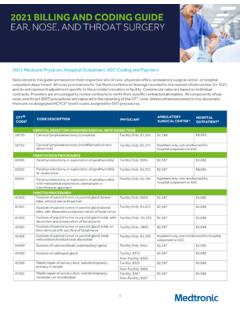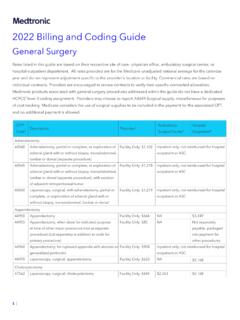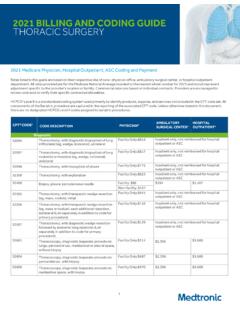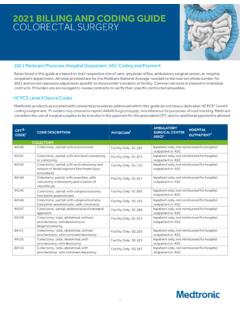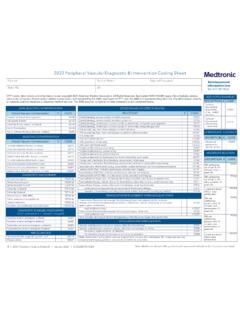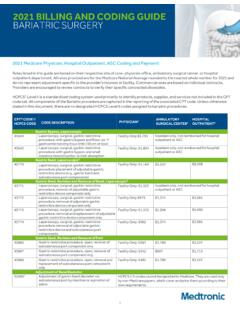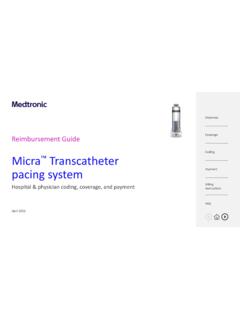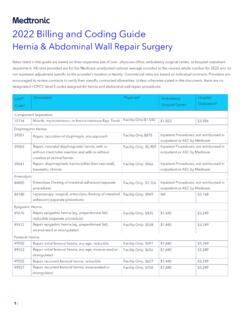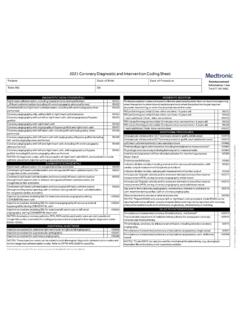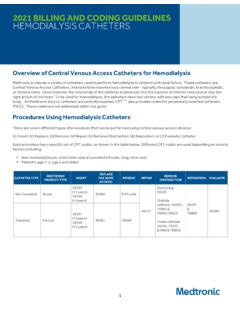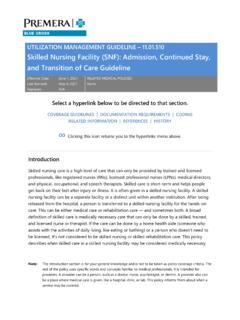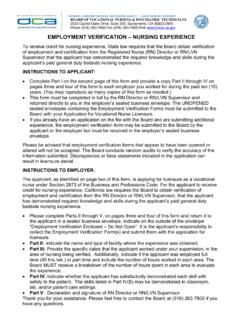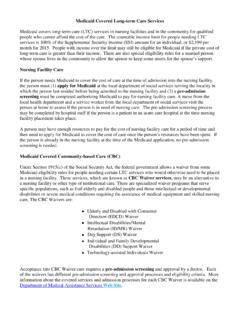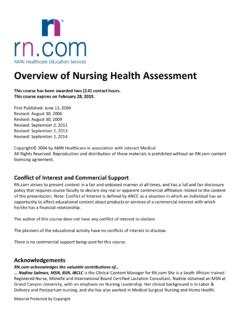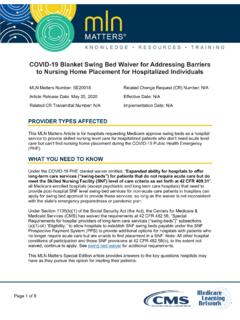Transcription of Skilled Nursing Facility Medicare Reimbursement Reference ...
1 Medicare Reimbursement GUIDE Skilled Nursing Facility (SNF) 1 EFFECTIVE OCTOBER 1, 2020 This guide provides an overview of Medicare Reimbursement methodologies and potential coding options for Skilled Nursing Facility care and FY21 Medicare payment rates. Reimbursement opportunities may exist under individual state Medicaid programs and commercial payer policies. Providers should consult with their appropriate payer contacts to ensure alignment on coverage, coding, and payment expectations for the uses of these technologies and/or the associated services. Skilled Nursing Facilities1 Skilled Nursing Facilities (SNFs) are acute care facilities that provide Skilled Nursing care or rehabilitation services for injured, disabled, or sick patients. Typically, a patient who has received inpatient hospital services, but requires extended services and ongoing daily care, may be admitted under physician orders into a SNF or swing bed Facility .
2 In rural areas where there are no dedicated SNFs, acute care level hospitals with fewer than 100 beds can use these beds either as acute care or SNF-level care as needed. These beds are considered swing beds. Patient Benefits1 SNFs are considered acute care hospitals and, as such, are covered under a patient's Medicare benefits for hospital insurance (Part A). In order to qualify for ongoing Skilled Nursing care in a SNF-level Facility , a patient is required to have received acute care in an inpatient hospital for at least three consecutive calendar days. The patient must also be transferred to the SNF within thirty days after discharge from the inpatient hospital. Medicare requires patient assessments at the start of a SNF admission and at periodic intervals throughout the stay. The initial assessment, known as the five-day assessment, must be completed within eight days of admission. The goal is for the care team to evaluate the patient's condition and decide on a care plan and goals.
3 Coverage1 Medical Necessity: As in all cases with services and products provided to Medicare patients, all necessary supplies and equipment which are ordinarily furnished by the hospital for the care and treatment of a patient during the SNF stay are considered covered services, even if the supplies or equipment leaves with the patient when discharged. Further, care in a SNF is covered by Medicare if all of the following four factors are met1: The patient requires Skilled Nursing services or Skilled rehabilitation services, , services that must be performed by or under the supervision of professional or technical personnel; are ordered by a physician, and the services are rendered for a condition for which the patient received inpatient hospital services or for a condition that arose while receiving care in a SNF for a condition for which he received inpatient hospital services; The patient requires these Skilled services on a daily basis; As a practical matter, considering economy and efficiency, the daily Skilled services can be provided only on an inpatient basis in a SNF.
4 And The services delivered are reasonable and necessary for the treatment of a patient's illness or injury, , are consistent with the nature and severity of the individual's illness or injury, the individual's particular medical needs, and accepted standards of medical practice. The services must also be reasonable in terms of duration and quantity. Because individual patient circumstances can affect SNF coverage and payment eligibility, it is advisable that providers seek further information from their carriers or CMS. Medicare Reimbursement Reference GUIDE Skilled Nursing Facility (SNF) Medicare Reimbursement GUIDE Skilled Nursing Facility (SNF) 2 Coding1 Coding for SNFs under Part A is reported under the ICD-10-CM, ICD-10-PCS, and revenue code systems. Payment is then made on a per diem basis (see below) under consolidated billing and is intended to cover all costs related to Part A services furnished in the SNF. For any portion of the stay that is eligible for Part B services, SNFs should report these separately using the appropriate HCPCS or CPT 5 codes.
5 Providers are advised first to check the following CMS website to determine whether a code is included or excluded from consolidated billing and whether it is eligible to be billed to Part B: Billing/SNFC onsolidatedBilling/Index Payment1 Payment for SNF stays is paid under the Medicare program on a per diem basis using the Skilled Nursing Facility Prospective Payment System (SNF PPS). The SNF PPS annual cycle begins on October 1st and runs through September 30th the following year. The SNF PPS payment rates are based on an adjusted federal rate and are intended to cover all routine, ancillary, and capital-related costs of the Part A stay. Adjustments are made for the individual Facility 's case mix using a classification system that accounts for resource utilization by patient type. Refer to the Patient Case-Mix Classification System below. SNFs bill the Medicare Administrative Contractors (MACs) for all routine, ancillary, and capital-related services that a patient receives during their covered Part A stay in that Facility under consolidated billing, with a few exceptions (see below).
6 Consolidated billing means that a Facility cannot "unbundle" any services that a patient receives through an outside supplier that could potentially be billed directly to the MAC under Part B. Instead, the SNF must make separate contractual arrangements with suppliers so that the SNF itself submits a single "consolidated bill" for each patient. Under federal statute, this includes physical, occupational, and speech-language therapy services. Beginning October 1, 2018, CMS reduced the adjusted federal per diem rate by two percent and adjusted the resulting rate by the value-based incentive payment amount earned by the SNF for that fiscal year under the SNF VPB Program. Additional SNF Billing and Payment Under Part B1 All routine, ancillary, and capital-related costs provided to a SNF patient are included in the Part A payment to that Facility and not separately billable. When no Part A payment is possible ( , if benefits are exhausted), some or all medically necessary services may be covered under Part B.
7 The SNF must bill these in order to be eligible for payment unless the patient is not entitled to Part B benefits. This includes3: Diagnostic x-ray tests, diagnostic laboratory tests, and other diagnostic tests X-ray, radium, and radioactive isotope therapy, including materials and services of technicians Surgical dressings, and splints, casts, and other devices used for the reduction of fractures and dislocations Prosthetic devices (other than dental) which replace all or part of an internal body organ (including contiguous tissue), or all or part of the function of a permanently inoperative or malfunctioning internal body organ, including replacement or repairs of such devices Leg, arm, back, and neck braces, trusses, and artificial legs, arms, and eyes including adjustments, repairs, and replacements required because of breakage, wear, loss, or a change in the patient's physical condition Outpatient physical therapy, outpatient speech-language pathology services, and outpatient occupational therapy Screening mammography services Screening pap smears and pelvic exams Influenza, pneumococcal pneumonia, and hepatitis B vaccines Some colorectal screening Prostate screening Ambulance services Hemophilia clotting factors EPO for ESRD patients when given in conjunction with dialysis.
8 Medicare Reimbursement GUIDE Skilled Nursing Facility (SNF) 3 Any durable medical equipment (DME) and supplies used during a SNF covered stay are included in the payment to that Facility and not separately billable. Subsequently, any DME and supplies furnished to a patient for use outside the Facility (home) should be billed under the patient's Part B benefits. If a SNF wishes to become a DME supplier, they must enroll with the National Supplier Clearinghouse and be given a separate supplier number for billing DME to the DME MAC. For Medtronic products, this may include ventilator accessories, enteral nutrition supplies, and remote monitoring devices. SNFs should bill the A/B MAC for prosthetic/orthotic devices under revenue code 274 and surgical dressings under revenue code 263. If the patient is not eligible for Part A benefits and is considered a SNF outpatient, supplies may be billed under revenue code 270. In all cases, the appropriate HCPCS code must be linked with the revenue code.
9 Of note, parenteral nutritional (PEN) therapies, along with the equipment, supplies, and nutrients, are, by definition, considered under the prosthetic device benefit for Medicare . Separately Billable Services Excluded from SNF Consolidated Billing2 A number of services are excluded from consolidated billing (CB) that may be separately billable to Part B for patients being treated in a SNF. Claims are filed by the individual provider. This includes services provided by physicians, physician assistants, nurse practitioners, clinical nurse specialists, certified nurse midwives, qualified psychologists, certified registered nurse anesthetists, hospice care related to a patient's terminal condition, and any ambulance trips bringing the patient to the SNF initial admission or from the SNF following discharge. Additional equipment and supplies described that are deemed excluded from CB include home dialysis supplies and equipment, self-care home dialysis support services, institutional dialysis services and supplies, and Epoetin Alfa (EPO).
10 Other services that CMS has deemed to be exceptionally intensive, costly or emergent that typically falls outside of SNF patient care plans are able to be billed to the Part B MAC separately. They include cardiac catheterization, CT scans, MRIs, emergency services, radiation therapy services, angiography, ambulatory surgery that involves the use of an OR, certain lymphatic and venous procedures, chemotherapy items/administration, radioisotope services, and customized prosthetics. Patient Case-Mix Classification System Upon admission to a SNF, Medicare patients must undergo an "initial assessment" using the Resident Assessment Instrument (RAI), which must be completed within eight days of admission. The care team's goal is to evaluate the patient's condition and decide on a care plan and goals. The RAI uses a minimum data set (MDS) of more than 300 items to describe a patient's physical and psychosocial needs. Patient Case-Mix Classification System Patient-Driven Payment Model (PDPM)3,4 CMS implemented a new case-mix classification system to classify SNF patients under the SNF PPS, beginning in FY20 (effective October 1, 2019), called the Patient-Driven Payment Model (PDPM).
